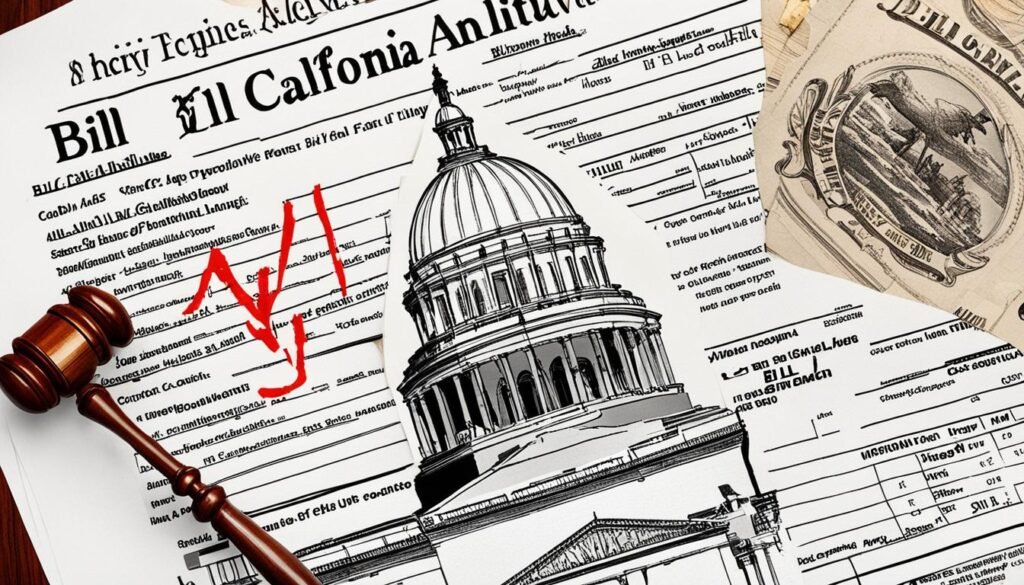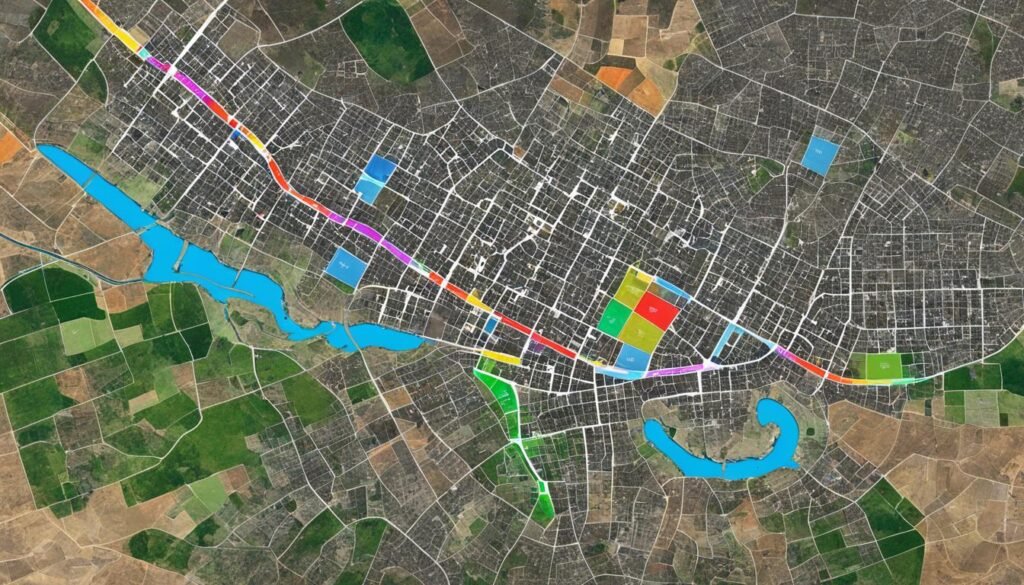In this section, I will provide you with the latest updates on the legislature in California. We will explore key aspects of the legislative process, including the history, committees, sessions, bills, power, agenda, district, hearings, and calendar. Stay informed with the most recent developments in the California legislature.
Key Takeaways:
- The legislative process in California involves various stages and stakeholders.
- Legislative committees play a crucial role in reviewing and shaping bills.
- Legislative sessions are held to discuss and debate proposed legislation.
- Understanding the legislative power and agenda helps to comprehend the decision-making process.
- Legislative districts determine the representation and allocation of resources within the state.
Understanding CA Term Limits for the Governor and Legislature
In California, term limits play a significant role in ensuring a rotation of leadership and opportunities for new voices in the state’s governance. Let’s explore the term limits for the governor and legislature in California.
Term Limits for the Governor
The governor of California is limited to serving two terms. This means that an individual can only hold the office of Governor for a maximum of eight years. After serving two consecutive terms, they are ineligible to run for re-election.
Term Limits for the Legislature
The California legislature, which consists of the State Assembly and the State Senate, also has term limits in place to avoid the concentration of power and encourage turnover among elected officials.
The term limits for members of the California State Assembly are as follows:
- Assembly members can serve a maximum of three two-year terms.
In the California State Senate, the term limits are:
- State Senators can serve a maximum of two four-year terms.
It’s important to note that term limits apply separately to each chamber. Therefore, a legislator can serve six years in the Assembly and then move on to serve another eight years in the Senate, if elected.
Number of Members in the California State Legislature
The California State Legislature is made up of 120 members in the State Assembly and 40 members in the State Senate. These individuals are elected by their respective districts and play a crucial role in representing the interests of their constituents.
Understanding the term limits for the governor and legislature in California is essential to grasp the dynamics of the state’s political landscape. These term limits ensure a healthy turnover of leadership, fostering new ideas and perspectives for the betterment of the state.
Overview of the Legislative Branch in California
As we delve into the workings of the California legislature, it is essential to understand the role, functions, and structure of the legislative branch in California. The legislative branch is a crucial component of the state government, responsible for enacting laws and representing the interests of the people.
The California legislature, also known as the California State Legislature, is the state’s legislative branch. It consists of two houses: the Assembly and the Senate. These two houses work together to shape and pass legislation that affects the daily lives of Californians.
The legislative branch plays a vital role in the state’s governance by providing a system of checks and balances. It ensures that no single individual or entity has absolute power and that decisions are made collectively for the betterment of the state.
Within the California legislature, there are committees that focus on specific policy areas and oversee the legislative process. These committees analyze proposed bills, hold hearings, and discuss the potential impact of legislation before it reaches the floor for a vote. This careful consideration helps ensure that the laws passed reflect the diverse needs and concerns of the state’s residents.
Furthermore, the legislative branch operates within specified legislative sessions, during which lawmakers convene to deliberate on various issues and prioritize legislative agendas. These sessions provide opportunities for lawmakers to debate, propose, and enact laws that address the pressing concerns of the state and its constituents.

The California legislature is an integral part of the state’s democratic process, as it allows for the representation of diverse voices and interests. It ensures that laws are created, amended, and repealed in a transparent and democratic manner.
As we explore the legislative process in greater detail in the following section, we will gain a deeper understanding of how the legislative branch translates public opinion and needs into actionable legislation.
The Legislative Process in California
Understanding the legislative process in California is essential to gain insight into how laws are made and enacted. In this section, we will take a closer look at the various steps involved in the legislative process, including the role of legislative committees, the legislative session, and the journey of a bill from introduction to enactment.
Introduction of a Bill
The legislative process begins with the introduction of a bill, which can be proposed by either a member of the Assembly or the Senate. Once a bill is introduced, it is assigned to a legislative committee for review and consideration.
Role of Legislative Committees
Legislative committees play a crucial role in shaping the fate of a bill. These committees thoroughly examine the proposed legislation, hold hearings, and solicit feedback from experts and stakeholders. They scrutinize the bill’s language, provisions, and potential impacts, making amendments or suggesting changes as needed.
Furthermore, committees often hold public hearings where individuals and organizations can voice their opinions and concerns regarding the bill. This allows for a comprehensive evaluation of its potential implications.
Legislative Session
The legislative session is the period during which the California State Legislature convenes to debate and discuss proposed bills. This session provides an opportunity for legislators to engage in meaningful discussions, negotiations, and debates on various legislative matters.
Journey of a Bill
Once a bill successfully passes through the legislative committee(s), it moves to the floor of the chamber (Assembly or Senate) for further consideration. Here, it undergoes a series of readings, debates, and voting by the lawmakers.
If the bill is approved by a majority vote in one chamber, it moves to the other chamber (Assembly if it originated in the Senate, or Senate if it originated in the Assembly) for a similar process. Again, if the bill receives approval from the second chamber, it proceeds to the Governor’s desk.
The Governor then has the power to sign the bill into law, veto it, or let it become law without a signature. This decision is based on various factors, including the bill’s content, the Governor’s policy priorities, and the broader interests of the state.
Legislative History and Milestones
California’s legislative process has a rich history that has shaped the state’s governance. Over the years, there have been significant legislative milestones that have brought about substantial changes and reforms.

Understanding the legislative process, its history, and the role of legislative committees, sessions, and bills is crucial for anyone interested in advocating for change or staying informed about the laws and policies that govern the state of California.
Understanding Legislative Power and Agenda in California
In California, the legislature wields significant power to create, amend, and repeal laws, shaping the state’s legal framework and governance. The legislative power is vested in the California State Legislature, consisting of two houses – the Assembly and the Senate. Together, they have the authority to make decisions that impact the lives of millions of Californians.
The legislative agenda refers to the set of priorities and issues that the legislature aims to address during a given legislative session. It determines the focus and direction of legislative activities, shaping the laws and policies that are considered. The agenda is influenced by various factors such as public opinion, political dynamics, and the needs of the state.
The legislative agenda plays a crucial role in guiding the activities of legislators and legislative committees. It helps prioritize the allocation of time, resources, and attention to specific policy areas. By setting an agenda, the legislature aims to address key issues, respond to current challenges, and advance the interests of California and its constituents.
Legislative power and agenda go hand in hand, as the power to legislate enables the legislature to pursue its agenda and fulfill its responsibilities. Legislators introduce and sponsor bills aligned with the agenda, initiating the legislative process that leads to the enactment of laws.
As California faces a multitude of complex and pressing issues, such as healthcare, education, climate change, and economic growth, the legislative power and agenda play a critical role in shaping the future of the state. By understanding how legislative power is exercised and the priorities outlined in the legislative agenda, citizens can actively engage in the democratic process and advocate for the policies that align with their values and concerns.

Stay informed about the legislative power and agenda in California to have a deeper understanding of the state’s governance and the initiatives being undertaken to address the needs of its diverse population.
Legislative Districts and Representation in California
In California, the state is divided into legislative districts to ensure fair representation of its population. These districts play a crucial role in the democratic process, as they determine who the constituents will elect to represent them in the California State Legislature.
The California State Legislature consists of two houses: the Assembly and the Senate. The Assembly has 80 members, while the Senate has 40 members. Each member represents a specific legislative district within the state.
Legislative districts are drawn based on population data from the U.S. Census Bureau. The goal is to create districts that have equal populations, allowing for equitable representation. The boundaries of these districts can change over time to accommodate shifts in population and maintain balance.
Members of the California State Legislature are elected by the residents of their respective districts, and they serve as the voice of their constituents in the legislative process. They play a vital role in creating and shaping laws that impact the lives of Californians.
The representation in the California State Legislature ensures that diverse communities and interests across the state have a voice in the decision-making process. It allows for a comprehensive and inclusive approach to governance, where the needs and concerns of different regions and demographics are taken into account.
By having a system of legislative districts and representation, California strives to ensure that the interests of its residents are represented adequately at the state level. The allocation of members in the California State Legislature allows for a balanced and representative government that reflects the diversity and complexity of the state.
Conclusion
In conclusion, our exploration of the legislature in California has provided valuable insights into various aspects of the state’s governance. We have covered topics such as term limits for the governor and legislature, the structure and function of the legislative branch, the legislative process, the power and agenda of the legislature, and the representation through legislative districts.
Throughout our discussion, we have emphasized the significance of legislative sessions, which provide opportunities for lawmakers to deliberate and make decisions on crucial issues affecting the state. These sessions serve as platforms for constructive debates and the formulation of policies that shape California’s future.
Furthermore, the importance of legislative hearings cannot be understated. These hearings serve as forums for public input and allow stakeholders to voice their opinions on proposed bills and policies. By actively participating in hearings, citizens can contribute to the legislative process and ensure their concerns are heard and considered.
Lastly, we have highlighted the significance of the legislative calendar, which plays a pivotal role in scheduling and organizing legislative activities. The calendar dictates the timeline for introducing, reviewing, and voting on bills, ensuring that the legislative process flows smoothly and efficiently.
FAQ
What is the legislative process in California?
The legislative process in California refers to the journey of a bill from its introduction to its enactment as a law. It involves several stages, including committee review, floor votes, and governor’s approval.
How many members are in the California state legislature?
The California state legislature consists of two houses: the Assembly and the Senate. The Assembly has 80 members, while the Senate has 40 members.
What are the term limits for the governor and legislature in California?
The term limit for the governor in California is two terms. As for the state legislature, Assembly members can serve up to three two-year terms, while Senators can serve up to two four-year terms.
What is the role of legislative committees in California?
Legislative committees in California play a crucial role in the legislative process. They review bills, conduct hearings, gather public input, and make recommendations for further action on proposed legislation.
What is the legislative power and agenda in California?
The legislative power in California allows the state legislature to create, amend, and repeal laws. The legislature sets its agenda by addressing key issues and priorities through the introduction and enactment of bills.
How are legislative districts and representation determined in California?
Legislative districts in California are determined through a process called redistricting, which occurs every ten years based on the results of the census. The number of members in the California state legislature represents these districts.







